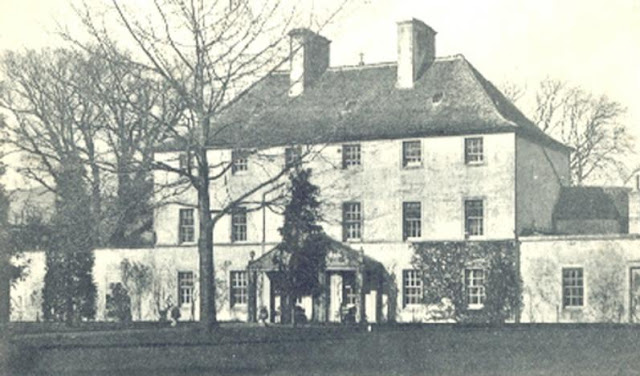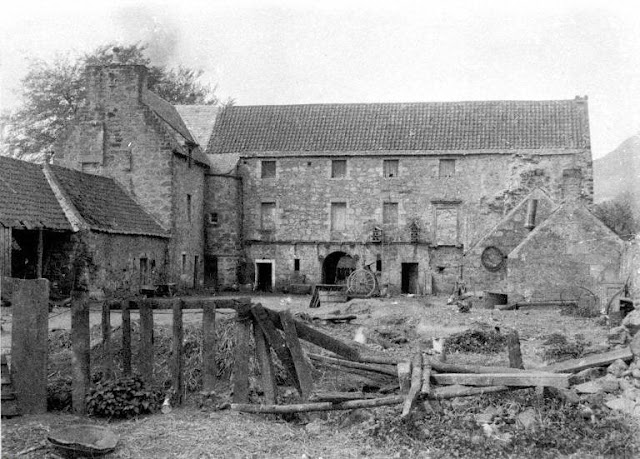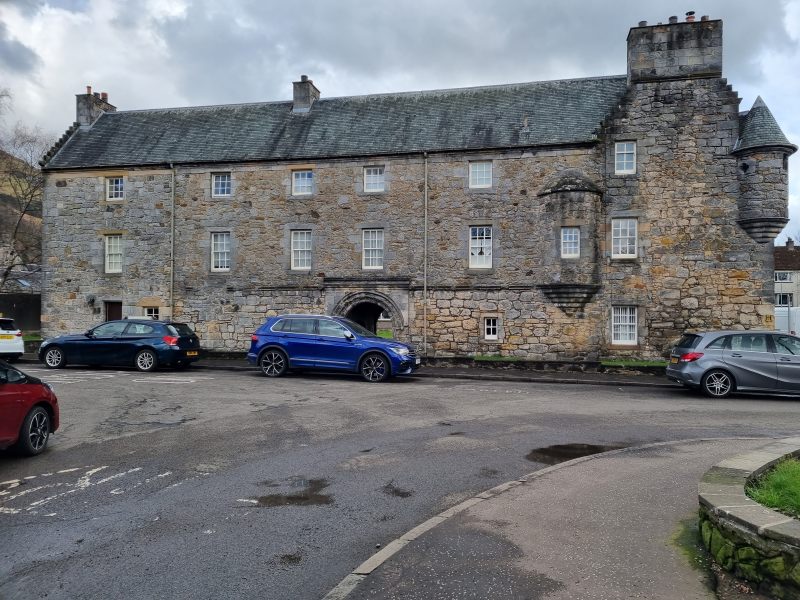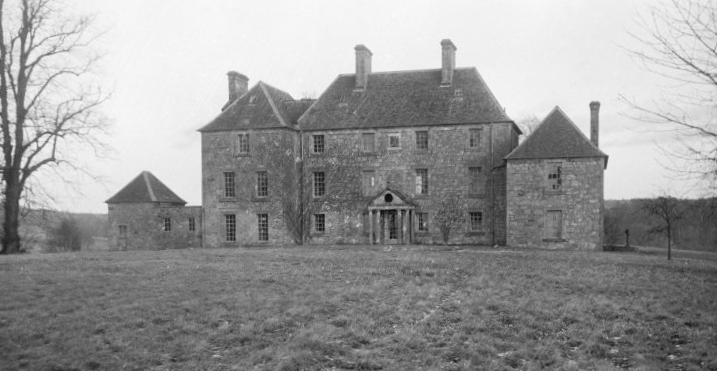Alexander Abercromby 1st of Tullibody (1675 - 1753).
Advocate and MP, Alexander was the third son of Sir Alexander Abercromby MP, 1st Baronet of Birkenbog (c.1603- December 1684). Alexander settled at Tullibody in Clackmannanshire, which he inherited from his cousin George Abercromby of Tullibody and Skeith following George's death in June 1699. Tullibody had previously been a possession of the Earls of Stirling.
Alexander was MP for Clackmannanshire from 1703 to 1707. He also bought Menstrie Castle (Menstrie, Clackmannanshire) in 1719. He married Mary Duff, daughter of Alexander Duff of Braco.
Alexander died in March 1753.
Children:
- George, 2nd of Tullibody baptized 8th July 1705
- Alexander baptized 27th May 1707, of Alloa, married 1732 Rebecca, daughter of Alexander Colquhoun
- James baptized 24th August 1708 of Brucefield; educated at Westminster, University of Leiden, Lincolns Inn (called to bar, 1738); attorney general of South Carolina, 1731-1744; member of South Carolina Assembly, 1739-1745; agent in London for North Carolina and Virginia, 1745-1771; MP for Clackmannanshire 1761-1768; deputy auditor-general of plantations 1757-1765. Lived on his brother George’s Brucefield estate (Clackmannanshire), 1757-1775, and owned substantial property (nearly 7,000 acres) in South Carolina.
- John baptized 1st May 1722
- William baptized 28th May 1723
- Robert baptized 28th October 1724
- Mary baptized 14th December 1710. Died young.
- Helen baptized 14th January 1713. Married her cousin Sir Robert Abercrombie, 3rd of Birkenbog
- Anna baptized 17th January 1719
George Abercromby, advocate (July 1705 - June 1800).
Purchased the Brucefield (Clackmannanshire) estate in about 1758. George had two distinguished soldiers among his sons. The elder was Lieutenant-General Sir Ralph Abercromby, who died from wounds received in the Battle of Aboukir in 1801, and whose widow was created Baroness Abercromby in his honour later the same year.
He married Mary, daughter of Ralph Dundas of Manour (Airthrey estate, Perthshire).
Children:
- George Abercromby (born 1728), baptised at Logie, 19th August 1728; perhaps died young.
- Sir Ralph Abercromby (1734-1801) Born October 1734 at Menstrie Castle. He rose to the rank of Lieutenant-General in the British Army, was appointed Governor of Trinidad, served as Commander-in-Chief, Ireland, and was noted for his services during the French Revolutionary Wars, ultimately in the Egyptian campaign. His strategies are ranked amongst the most daring and brilliant exploits of the British army.
- Captain Burnet Abercromby of Brucefield, MP for Clackmannanshire (1738-1792).
- General Sir Robert Abercromby (1740-1827), a General in the Army; commander-in-chief in India, 1793; Governor of Edinburgh Castle; MP for Clackmannanshire 1798-1802; purchased Airthrey Castle in 1798 before it was fully completed and was responsible for landscaping the park and building the lodges; died unmarried and the estate passed to his nephew, George Abercromby (1770-1843), 2nd Baron Abercromby.
- Alexander Abercromby (1745-1795), advocate; lord of sessions as Lord Abercromby; died unmarried.
- Helen Abercromby, married, 1754, Robert Bruce (1718-1785), Lord Kennet and had issue.
- Mary Abercromby, married Major Alexander Joass (died 1794), Governor of Stirling, and had issue.
He inherited from his father the Tullibody House and Menstrie Castle estates on his death in 1753.
George died in June 1800.
Sir Ralph Abercromby (1735-1801).
Sir Ralph was born 25th October 1735, the eldest son of George Abercromby. He entered the army in 1756 and was appointed Colonel of the 103rd Foot in 1781 and Major-General in 1787. In August 1795 he was Commander-in-Chief of British forces in the West Indies; in 1798 he was given command of forces in Ireland, and shortly afterwards of those in Scotland, with the governorships of Fort Augustus and Fort George. Early in 1801 he had command of British forces in Egypt and at the famous second battle of Aboukir he received a wound of which he died shortly afterwards. He was appointed a Knight of the Bath in 1797 and was a member of the Privy Council.
He married on 17th November 1767, Mary Anne (1747-1821), second daughter and co-heir of John Menzies of Ferntower, Crieff (Perthshire), who when an account of the triumph and death of her husband reached England, was created Baroness Abercromby in his memory, and awarded a pension of £2,000 a year for herself and the next three inheritors of the title.
Children:
- George Abercromby (1770-1843), 2nd Baron Abercromby
- Lieutenant-General Sir John Abercromby (1772-1817) GCB, a Lieutenant-General in the Army; colonel of 53rd Regiment; captured Mauritius 1809; died unmarried at Marseilles
- James Abercromby (1776-1858), 1st Baron Dunfermline
- Anne Abercromby (died 1844), married, 1795, Donald Cameron (died 1832) of Lochiel
- Catherine Abercromby (died 1841), married, 1811, Thomas Buchanan
- Lieutenant-Colonel Alexander Abercromby (1784-1853), served in the Peninsular War and at Waterloo; MP for Clackmannanshire 1817; died unmarried “at his country seat in Clackmannanshire”, 27 August 1853.
- Mary Abercromby (died 1825).
He inherited his father’s estates in 1800 but was killed shortly afterwards. It is not clear what property if any he inherited from his wife’s father. He died on 28th March 1801, and was buried in the burial ground of the Commandery of the Grand Master under the walls of the castle of St. Elmo at Valetta (Malta). He is commemorated by a monument in St. Paul’s Cathedral ordered by the House of Commons.
General Sir Robert Abercromby (1740-1827).
A General in the Army; commander-in-chief in India, 1793; Governor of Edinburgh Castle; MP for Clackmannanshire 1798-1802; purchased Airthrey Castle in 1798 before it was fully completed and was responsible for landscaping the park and building the lodges; died unmarried and the estate passed to his nephew, George Abercromby (1770-1843), 2nd Baron Abercromby.
George Abercromby (1770-1843), 2nd Baron Abercromby.
Born on 17th October 1770, the eldest son of Major-General Sir Ralph Abercromby (1735-1801). MP for Edinburgh 1805-06, Clackmannanshire 1806-07 and 1812-15. Lord Lieutenant of Stirlingshire 1837-43. He married on 20th January 1799 at Edinburgh, Montague (1772-1837), daughter of Henry Dundas (1742-1811), 1st Viscount Melville.
Children:
- George Ralph Abercromby (1800-1852), 3rd Baron Abercromby
- Montague Abercromby (1807-1853), married, 1831, Right Honourable Fox Maule (later Maule-Ramsay) (1801-1874), 2nd Baron Panmure
- Mary Anne Abercromby (1811-1898), married, 1857, Colonel N.R. Brown (died 1870).
He inherited Tullibody House from his mother in 1821 and Airthrey Castle from his uncle, Sir Robert Abercromby (1740-1827) in 1827. He died at Airthrey Castle on 14th February 1843 and was buried at Tullibody. He was succeeded in his title and estates by his son.
Colonel George Ralph Abercromby (1800-52), 3rd Baron Abercromby.
Born 30 May 1800, only son of George Abercromby (1770-1843), 2nd Baron Abercromby. MP for Clackmannan and Kinross, 1824-1831, Stirlingshire 1838-1841 and Clackmannanshire and Kinross-shire 1841-1852; Lord Lieutenant and Sheriff-Principal of Clackmannanshire 1840-1852. Served in the Army (Major 1826; Colonel). He married on 3rd April 1832, Louisa Penuel (c.1810-1882), daughter of John Hay Forbes, Lord Medwyn.
Children:
- Montagu Abercromby (1835-1931), married 1856 George Frederick Boyle, 6th Earl of Glasgow (died 1890) and had issue
- George Ralph Campbell Abercromby (1838-1917), 4th Baron Abercromby
- John Abercromby (1841-1924), 5th Baron Abercromby
- Ralph Abercromby (1842-1897), died unmarried.
He inherited Tullibody House and Airthrey Castle from his father in 1843. He died at Airthrey Castle, on 25th June 1852 and was buried at Tullibody.
George Ralph Campbell Abercromby(1838-1917), 4th Baron Abercromby.
Born on 23rd September 1838, eldest son of Colonel George Ralph Abercromby (1800-52), 3rd Baron Abercromby. He was a JP for Stirlingshire and Clackmannanshire and DL for Stirlingshire. He married on 6th October 1858, Lady Julia Janet Georgiana Duncan (died 1915), a lady of the bedchamber to Queen Victoria, daughter of Adam, 2nd Earl of Camperdown, but had no issue.
He inherited Airthrey Castle and Tullibody House from his father in 1852, but sold the Castle between 1882 and 1905. He lived at Tullibody House. He died in London on 30th October 1917, when his title passed to his younger brother, John Abercromby.
John Abercromby (1841-1924), 5th Baron Abercromby, antiquarian.
Born on 15th January 1841, second son of Colonel George Ralph Abercromby (1800-52), 3rd Baron Abercromby. Lieutenant, Rifle Brigade. President of the Society of Antiquaries of Scotland; Hon LL.D, Edinburgh University. He succeeded his brother as 5th Baron Abercromby, on 30th October 1917. He married on 26th August 1876 (divorced 1879) his cousin, Adele Wilhelmine Marika, daughter of Chevalier Charles von Heidenstam, Swedish Minister at the Court of Athens.
Children:
- Edla Louisa Montagu (born 1877), married, in 1906, Georges N. Nasos, director of the conservatory of music at Athens and officer of the Order of the Saviour, Greece.
He apparently sold Tullibody House and lived at 62 Palmerston Rd, Edinburgh in 1923. He died on 7th October 1924, when the barony of Abercromby became extinct. Tullibody House, which consisted of a main block and two wings, was burnt and demolished c.1963.
Tullibody House

Tullibody House - postcard image
The house sat on a magnificent site by the shore of the River Forth. A house was built here in the 1650s by Robert Meldrum, but was rebuilt about 1710 by Alexander Abercromby (1675-1753), who also laid out fir plantations and formal gardens around it after 1725. The house had a main block of three storeys and six bays, with a tall hipped roof, joined by curved one and a half storey links to two-storey pavilions at right angles to the entrance front. William Stirling carried out unidentified alterations in c.1803 at a cost of around £2,109.
In the 19th century the setting of the house became industrialised, and it was demolished in 1963 as a result of a fire.
Descent:
Sold 1648 to Robert Meldrum; 1662 to brother, Major George Meldrum, who sold 1662 to William Sharp, who sold 1679 to George Abercromby of Skeith; 1699 to cousin, Alexander Abercromby; 1753 to son, George Abercromby 1800; to son, Sir Ralph Abercromby, kt. 1801; to widow, Mary Anne Abercromby, 1st Baroness Abercromby 1821; to son, George Abercromby, 2nd Baron Abercromby; 1843 to son, George Ralph Abercromby, 3rd Baron Abercromby; 1852 to son, George Ralph Campbell Abercromby, 4th Baron Abercromby; 1917 to brother, John Abercromby, 5th Baron Abercromby, who apparently sold the house before 1923; Major Hugh Carlisle Campbell Forrester DL (fl. 1939)
Menstrie Castle

Menstrie Castle (rear) before restoration.
A sturdy, picturesque three-storey L-plan castellated house with steep roof, crowstepped gables, dormer windows and pepperpot turrets, probably the remaining part of a full quadrangle, entered through a wide-arched gateway. The house was burnt by the Marquess of Montrose during the Civil War, and later in the 17th century a new laird’s house (Windsor House) – now demolished – was built opposite.

Menstrie Castle (front) 2022
After centuries of neglect and misuse, it was saved from demolition by a campaign led by the actor Moultrie Kelsall in 1960-1964 and converted into flats, a museum and coffee shop. It is a wealthy manor house rather than a defensible castle, and is now surrounded by a simple square of housing designed by W.H. Henry, 1957-1960. The castle now contains a commemoration room to the baronets of Nova Scotia administered by the NTS, in recognition of the fact that Sir William Alexander, 1st Earl of Stirling, founder of Nova Scotia, was born here.
Descent:
Built c.1560 for William Alexander; c.1574 to Sir William Alexander, 1st Earl of Stirling; 1640 to Robert Murray of Woodend (Perthshire), mortgagor foreclosed before 1640; burnt 1645; sold 1649 to Major James Holborne of Menstrie; to son, James Holborne of Menstrie; to son, Sir James Holburn of Menstrie, 1st baronet., who sold 1719 to Alexander Abercromby of Tullibody; 1753 to son, George Abercromby; 1800 to son, Sir Ralph Abercromby, kt.; 1801 to widow, Mary Anne Abercromby, 1st Baroness Abercromby; 1821 to son, George Abercromby, 2nd Baron Abercromby; 1843 to son, George Ralph Abercromby, 3rd Baron Abercromby; 1852 to son, George Ralph Campbell Abercromby, 4th Baron Abercromby; 1917 to brother, John Abercromby, 5th Baron Abercromby; sold 1924 after his death.
Brucefield

Brucefield - Canmore image
A plain three storey house in the earliest classical manner introduced to Scotland by Sir William Bruce, built c.1724 for Alexander Bruce of Kennet. The central block has a tall hipped slate roof and prominent chimneystacks and four widely-spaced windows, and to either side are lower hipped-roofed wings. The two storey south wing was added c.1760 and the three-storey north wing in the early 19th century. The entrance is now through a Doric porch on the west front, but was formerly at first floor level on the east. The house was restored by James Shearer of Dunfermline in the 1930s for the 7th Lord Balfour of Burleigh.
Descent:
Alexander Bruce; 1747 to son, Robert Bruce, Lord Kennet, who sold c.1758 to his father-in-law, George Abercromby of Tullibody, who leased it to his brother James (died 1775) and then to his son, Captain Burnet Abercromby (died 1792); to son, Gen. Sir Robert Abercromby; sold to great-nephew, Robert Bruce of Kennet; 1864 to son, Sir Alexander Hugh Bruce, 6th Lord Balfour of Burleigh; 1921 to son, George John Gordon Bruce, 7th Lord Balfour of Burleigh; 1967 to son, Robert Bruce, 8th Lord Balfour of Burleigh; 2019 to Victoria Bruce-Winkler, 9th Lady Balfour of Burleigh.
Airthrey Castle

Airthrey Castle - Internet Image
A D-shaped castle-style house, which however employs mainly Classical forms, designed by Robert Adam in 1790-1791 for Robert Haldane. Haldane dismissed Adam after the plans had been supplied, and redirected the money for architects’ fees to building in ashlar instead of rubble. Haldane sold the house to Sir Robert Abercromby in 1798 when it was not quite finished, and went off to be a missionary in Bengal.
The house was enlarged, the north-facing entrance front rebuilt in a loosely Baronial style and the interior extensively altered by David Thomson for Donald M. Graham in 1891. The hall has a lavish late 19th century interior with panelling and a massive timber fireplace. The lodges, one of which has been demolished, were designed by William Stirling for Sir Robert Abercromby in 1809. The park was landscaped by Thomas White c.1798 and by Alexander Nasymth, c.1802, and now accommodates the main Stirling University campus: the lake survives, but a late 18th century hermitage on a clifftop overlooking Airthrey Loch is now just rubble. The house was used as a maternity hospital from 1939-1969, and a nurses’ home was built extending east from the Victorian service court. In 1966 it was acquired by the University, which has effected considerable refurbishment.
Descent:
Robert Haldane; sold 1798 to Sir Robert Abercromby; 1827 to nephew, George Abercromby, 2nd Baron Abercromby; 1843 to son, George Ralph Abercromby, 3rd Baron Abercromby; 1852 to son, George Ralph Campbell Abercromby, 4th Baron Abercromby, who sold 1889 to Donald M. Graham; 1901 to widow, Mrs. Graham and her Trustees; leased as maternity hospital 1939; sold 1946 to Stirling County Council; transferred 1966 to University of Stirling.
